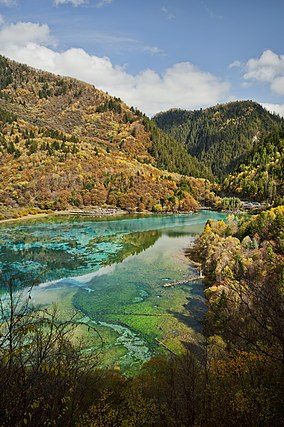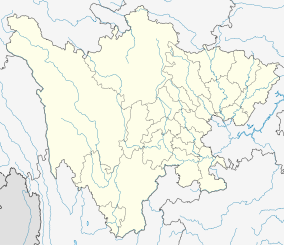Jiuzhaigou
| Jiuzhaigou 九寨沟 |
|
|---|---|
|
IUCN category III (natural monument or feature)
|
|

Five Flower Lake
|
|
| Location | Jiuzhaigou County, Sichuan |
| Nearest city | Songpan |
| Coordinates | 33°12′N 103°54′E / 33.200°N 103.900°ECoordinates: 33°12′N 103°54′E / 33.200°N 103.900°E |
| Area | 720 km2 (280 sq mi) |
| Established | 1978 |
| Visitors | 1,190,000 (in 2002) |
| Governing body | Sichuan Provincial Commission for Construction |
| Official name | Jiuzhaigou Valley Scenic and Historic Interest Area 九寨沟风景名胜区 |
| Type | Natural |
| Criteria | vii |
| Designated | 1992 (16th session) |
| Reference no. | 637 |
| State Party | China |
| Region | Asia-Pacific |
| Jiuzhaigou | |||||||||||||||||||||||||

"Valley of Nine Fortified Villages (Jiuzhaigou)" in Simplified Chinese (top), Traditional Chinese (middle), and Tibetan (bottom) characters
|
|||||||||||||||||||||||||
| Chinese name | |||||||||||||||||||||||||
|---|---|---|---|---|---|---|---|---|---|---|---|---|---|---|---|---|---|---|---|---|---|---|---|---|---|
| Simplified Chinese | 九寨沟 | ||||||||||||||||||||||||
| Traditional Chinese | 九寨溝 | ||||||||||||||||||||||||
| Literal meaning | "Valley of Nine Fortified Villages" | ||||||||||||||||||||||||
|
|||||||||||||||||||||||||
| Tibetan name | |||||||||||||||||||||||||
| Tibetan | གཟི་རྩ་སྡེ་དགུ། | ||||||||||||||||||||||||
|
|||||||||||||||||||||||||
| Transcriptions | |
|---|---|
| Standard Mandarin | |
| Hanyu Pinyin | Jiǔzhàigōu |
| Wade–Giles | Chiu3-chai4-kou1 |
| IPA | [tɕi̯òu̯ʈʂâi̯kóu̯] |
| Wu | |
| Romanization | Jieu平 tsae入 koe平 |
| Yue: Cantonese | |
| Yale Romanization | Gáu-jaaih-gāu |
| Jyutping | Gau2-zaai6-gau1 |
| Southern Min | |
| Tâi-lô | Káu-tsē-kau |
| Transcriptions | |
|---|---|
| Wylie | gzi-rtsa sde-dgu |
| Tibetan Pinyin | Sirza Degu |
Jiuzhaigou (pronounced pinyin: jiǔzhài gōu;[tɕi̯òu̯ʈʂâi̯kóu̯]; Chinese: 九寨沟; literally: "Valley of Nine Fortified Villages"; Tibetan: གཟི་རྩ་སྡེ་དགུ།, ZYPY: Sirza Degu) is a nature reserve and national park located in the north of Sichuan province, China.
Jiuzhaigou Valley is part of the Min Mountains on the edge of the Tibetan Plateau and stretches over 72,000 hectares (180,000 acres). It is known for its many multi-level waterfalls, colorful lakes, and snow-capped peaks. Its elevation ranges from 2,000 to 4,500 metres (6,600 to 14,800 ft).
Jiuzhaigou Valley was inscribed by UNESCO as a World Heritage Site in 1992 and a World Biosphere Reserve in 1997. It belongs to the category V (Protected Landscape) in the IUCN system of protected area categorization.
Jiuzhaigou (literally "Nine Village Valley") takes its name from the nine Tibetan villages along its length.
The remote region was inhabited by various Tibetan and Qiang peoples for centuries. Until 1975 this inaccessible area was little known. Extensive logging took place until 1979, when the Chinese government banned such activity and made the area a national park in 1982. An Administration Bureau was established and the site officially opened to tourism in 1984; layout of facilities and regulations were completed in 1987.
...
Wikipedia

